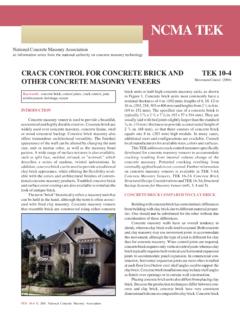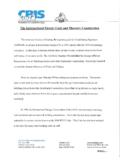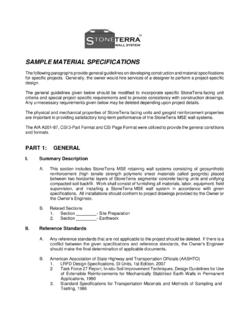Transcription of JOINT REINFORCEMENT TEK 12-2B FOR CONCRETE MASONRY
1 TEK 12-2B 2005 National CONCRETE MASONRY Association (replaces TEK 12-2A)NCMA TEKN ational CONCRETE MASONRY Associationan information series from the national authority on CONCRETE MASONRY technologyJOINT REINFORCEMENT FOR CONCRETE MASONRY TEK 12-2 BReinforcement & Connectors (2005)Keywords: cavity wall, building code, connectors, flexural strength, JOINT REINFORCEMENT , movement control, multiwythe wall, veneer, wall tiesINTRODUCTION Standard JOINT REINFORCEMENT for CONCRETE MASONRY is a factory-fabricated welded wire assembly consisting of two or more longitudinal wires connected with cross wires form-ing a truss or ladder configuration.
2 It was initially conceived primarily to control wall cracking associated with thermal or moisture shrinkage or expansion and as an alternative to MASONRY headers when tying MASONRY wythes together. Note that horizontal steel requirements for crack control can be met using JOINT REINFORCEMENT or reinforcing bars. See Crack Control in CONCRETE MASONRY Walls, TEK 10-1A (ref. 6). JOINT REINFORCEMENT also increases a wall s resistance to horizontal bending, but is not widely recognized by the model building codes for structural purposes.
3 In some instances, it may be used in design for flexural resistance or to meet prescriptive seismic requirements. This TEK discusses the code and specification require-ments for JOINT REINFORCEMENT and presents a general discussion of the function of JOINT REINFORCEMENT in CONCRETE MASONRY walls. Detailed information on additional uses for JOINT rein-forcement can be found in other TEK as referenced throughout this types used in MASONRY principally are reinforcing bars and cold-drawn wire products. JOINT REINFORCEMENT is governed by Standard Specification for MASONRY JOINT REINFORCEMENT , ASTM A 951 (ref.)
4 1), or Standard Specification for Stainless Steel Wire, ASTM A 580/580M Type 304 or Type 316 (ref. 2), if the JOINT REINFORCEMENT is stainless steel according to the Specification for MASONRY Structures (ref. 3). Cold-drawn wire for JOINT REINFORCEMENT varies from to (11 gage to 1/4 in. diameter; MW7 to MW32), the most popular size being (9 gage, MW11). Wire for MASONRY is plain, except side wires for JOINT REINFORCEMENT are deformed by means of knurling wheels. Because Building Code Requirements for MASONRY Structures (ref.
5 4) limits the size of JOINT REINFORCEMENT to one half the JOINT thickness, the practical limit for wire diameter is , (3/16 in., MW17) for a 3/8 in. ( mm) bed JOINT . JOINT REINFORCEMENT of this thickness may be difficult to install however, if a uniform mortar JOINT thickness of 3/8 in. ( mm) is to be maintained. Types of JOINT ReinforcementReflecting its multiple purposes in MASONRY walls, JOINT REINFORCEMENT comes in several configurations. One longitudinal wire is generally required for each bed JOINT ( , two wires for a typical single wythe wall), but code or specification requirements may dictate otherwise.
6 Typical JOINT REINFORCEMENT spacing is 16 in. (406 mm) on center. Adjustable ties, tabs, third wires and seismic clips are also available in combination with JOINT REINFORCEMENT for multiwythe and veneer walls. ladder-type JOINT REINFORCEMENT (Figure 1) consists of longitudinal wires flush welded with perpendicular cross wires, creating the appearance of a ladder. It is less rigid than truss-type JOINT REINFORCEMENT and is recommended for multiwythe walls with cavity spaces or unfilled collar joints. This permits the two wythes to move independently, yet still transfers out-of-plane loads from the exterior MASONRY to the interior MASONRY wall.
7 Cross wires 16 in. (406 mm) on center should be used for reinforced CONCRETE MASONRY construction, to keep cross wires out of the core spaces, thus preventing them from interfering with the placement of vertical REINFORCEMENT and grout. Figure 2 Truss-Type JOINT Reinforcement16 in. (406 mm) 1 ladder-Type JOINT Reinforcement16 in. (406 mm) Truss-type JOINT REINFORCEMENT (Figure 2) consists of longitudinal wires connected with diagonal cross wires. This shape is stiffer in the plane of the wall than ladder-type JOINT REINFORCEMENT and if used to connect multiple wythes restricts differential movement between the wythes.
8 For this reason, it should be used only when differential movement is not a concern, as in single wythe CONCRETE MASONRY walls. Because the diagonal cross wires may interfere with the placement of vertical reinforcing steel and grout, truss-type JOINT REINFORCEMENT should not be used in reinforced or grouted walls. Tabs, ties, anchors, third wires and seismic clips of assorted configurations are often used with the JOINT REINFORCEMENT to produce a system that works to: control cracking; bond MASONRY wythes together; anchor MASONRY ; and, in some cases, resist structural loads.
9 Tie and anchor spacing and other requirements are included in Anchors and Ties for MASONRY , TEK 12-1A ( ). Recommendations for the use of some of the different types of JOINT REINFORCEMENT are listed in Table PROTECTION Grout, mortar and MASONRY units usually provide adequate protection for embedded REINFORCEMENT , provided that minimum cover and clearance requirements are met. Coating Requirements The carbon steel in JOINT REINFORCEMENT can be protected from corrosion by coating with zinc (galvanizing). The zinc protects steel in two ways.
10 First, it provides a barrier between the steel and oxygen and water. Second, during the corrosion process, the zinc provides a sacrificial coating. The protective value of the zinc coating increases with increased coating thickness; therefore the required amount of galvanizing increases with the severity of exposure, as listed below (refs. 3, 4): Interior walls exposed to a mean relative humidity less than or equal to 75%:Mill galvanized, ASTM A 641 ( oz/ft2) ( kg/m2)Hot-dip galvanized, ASTM A 153 ( oz/ft2) (458 g/m2)Stainless steel AISI Type 304 or Type 316 conforming to ASTM A 580 Exterior walls or interior walls exposed to a mean relative humidity > 75%.


